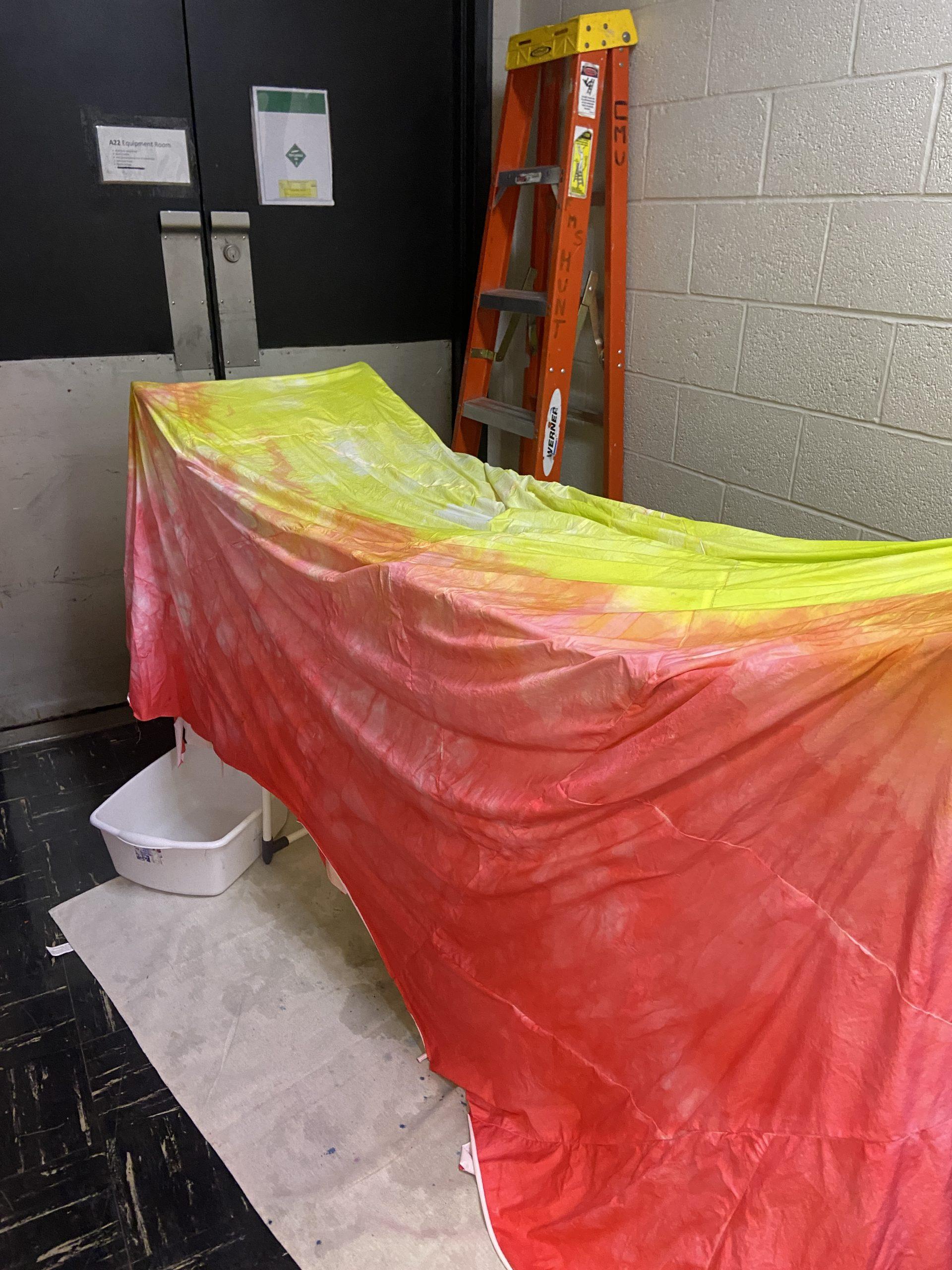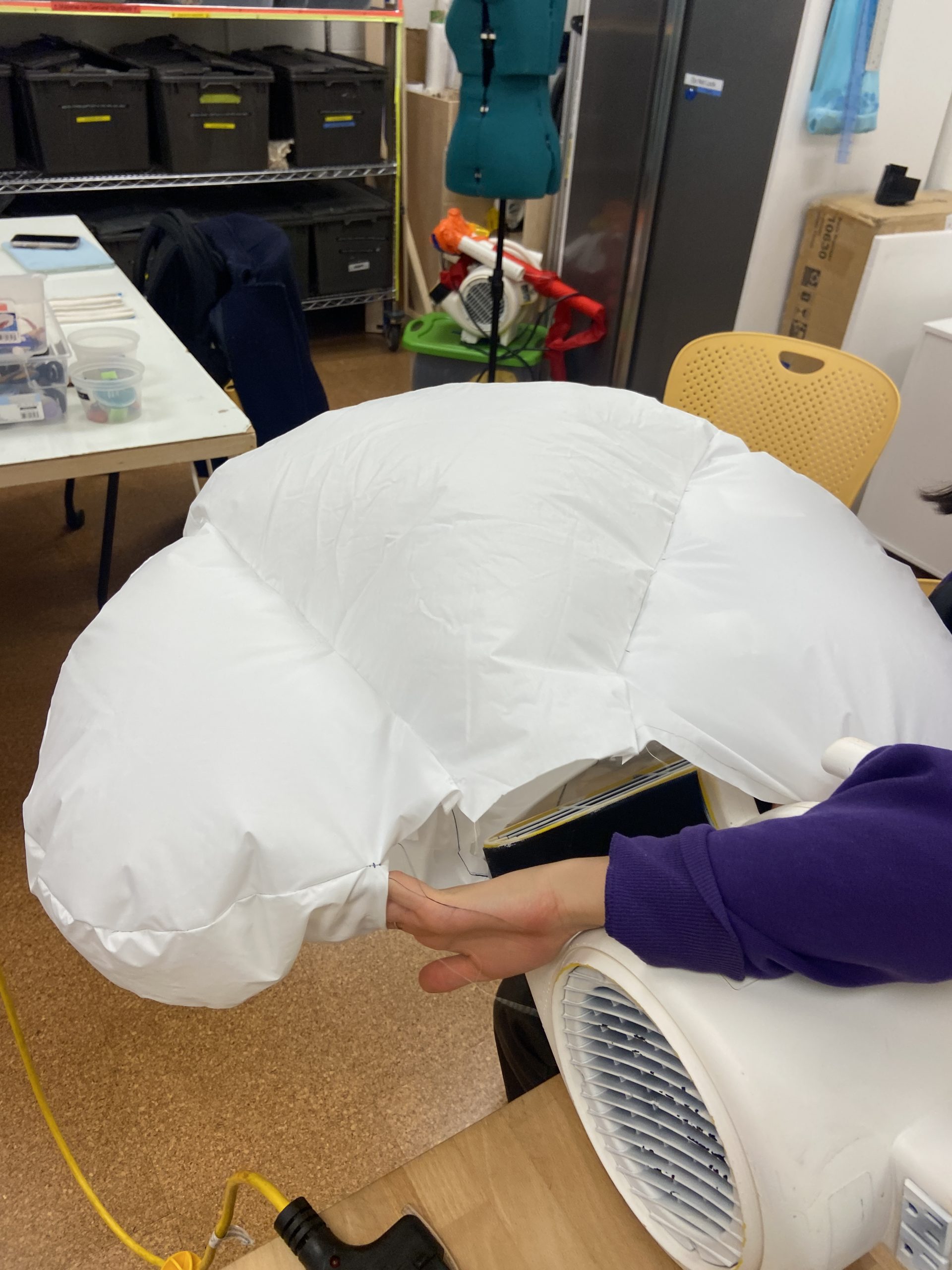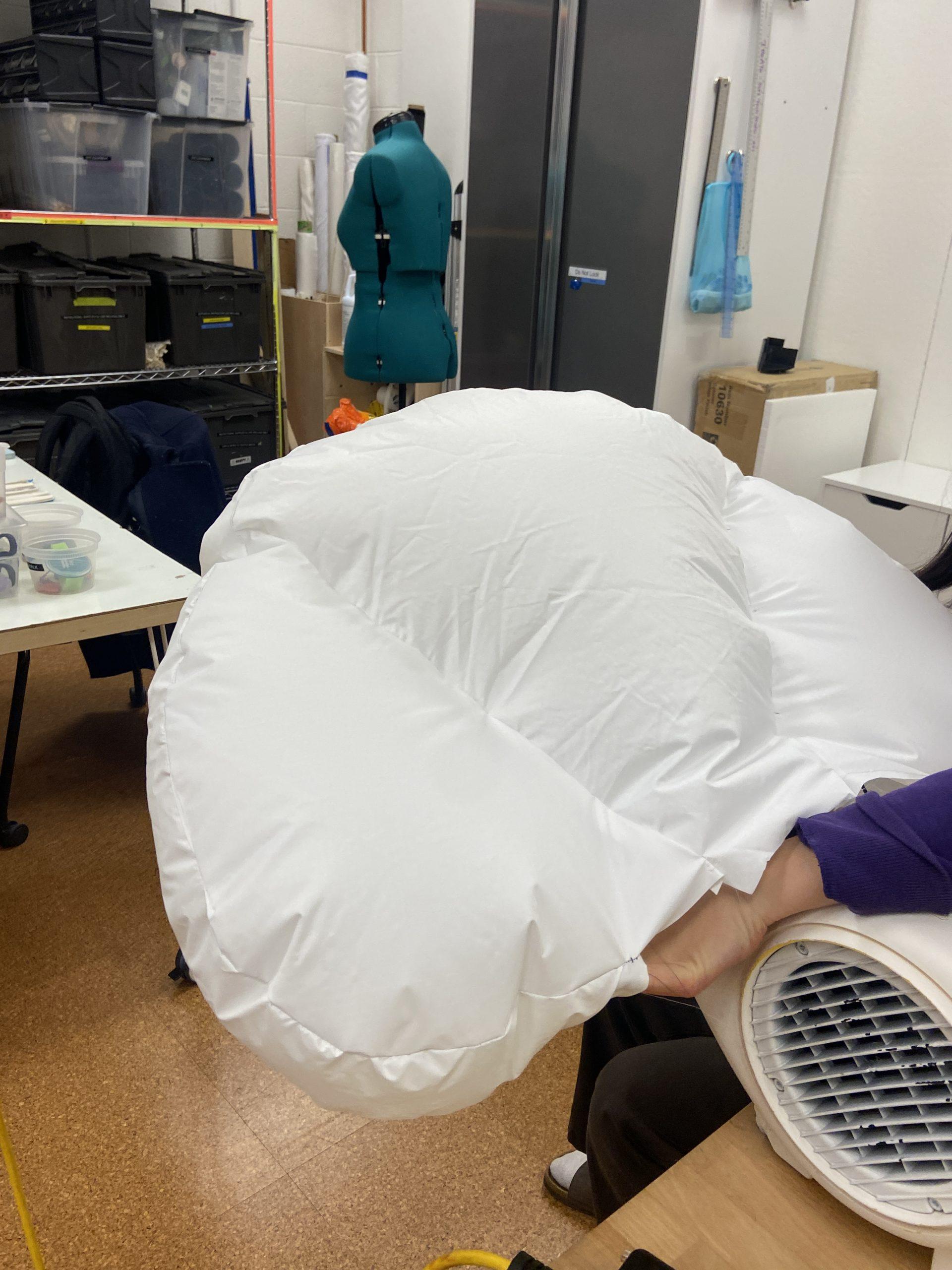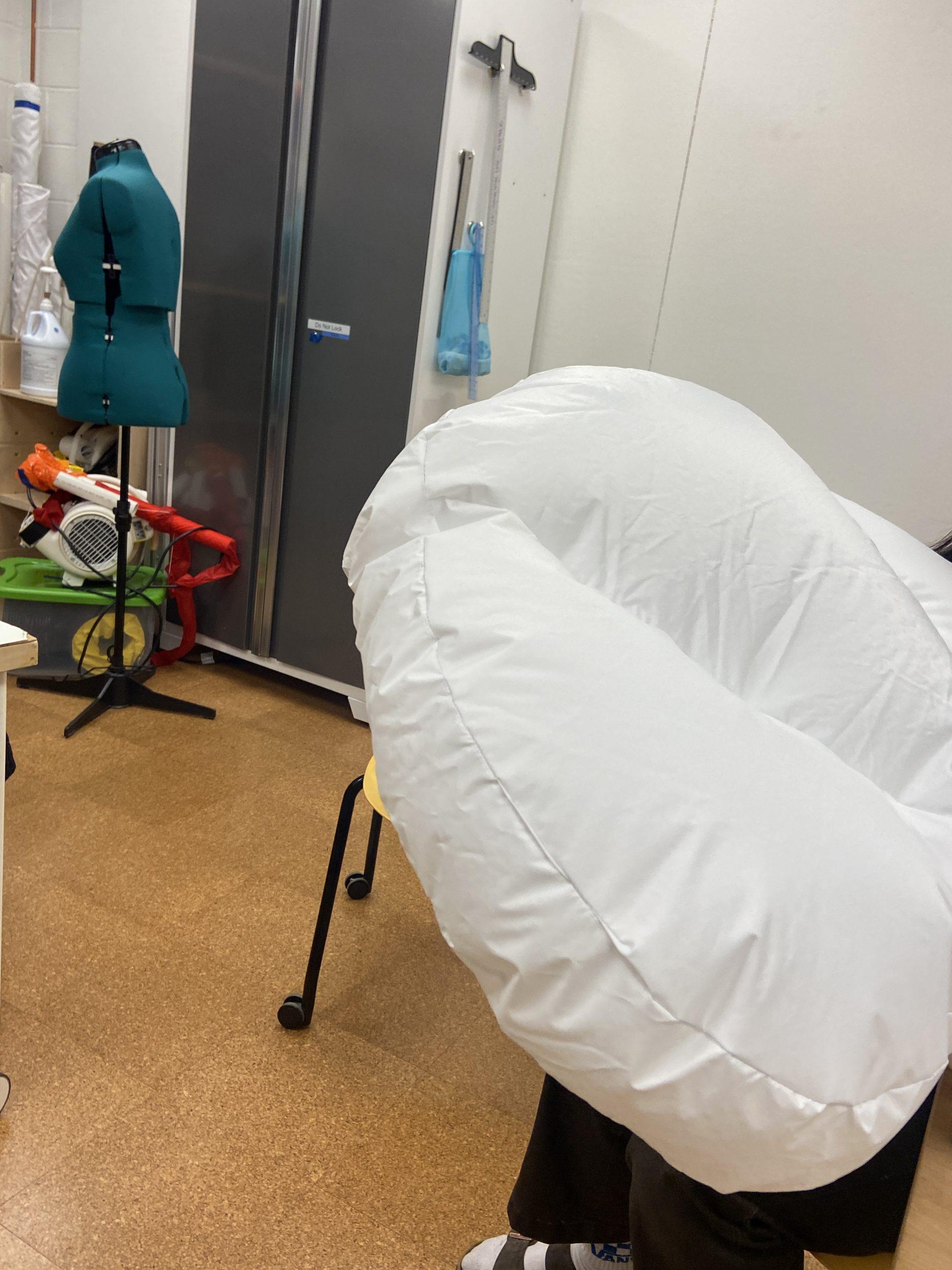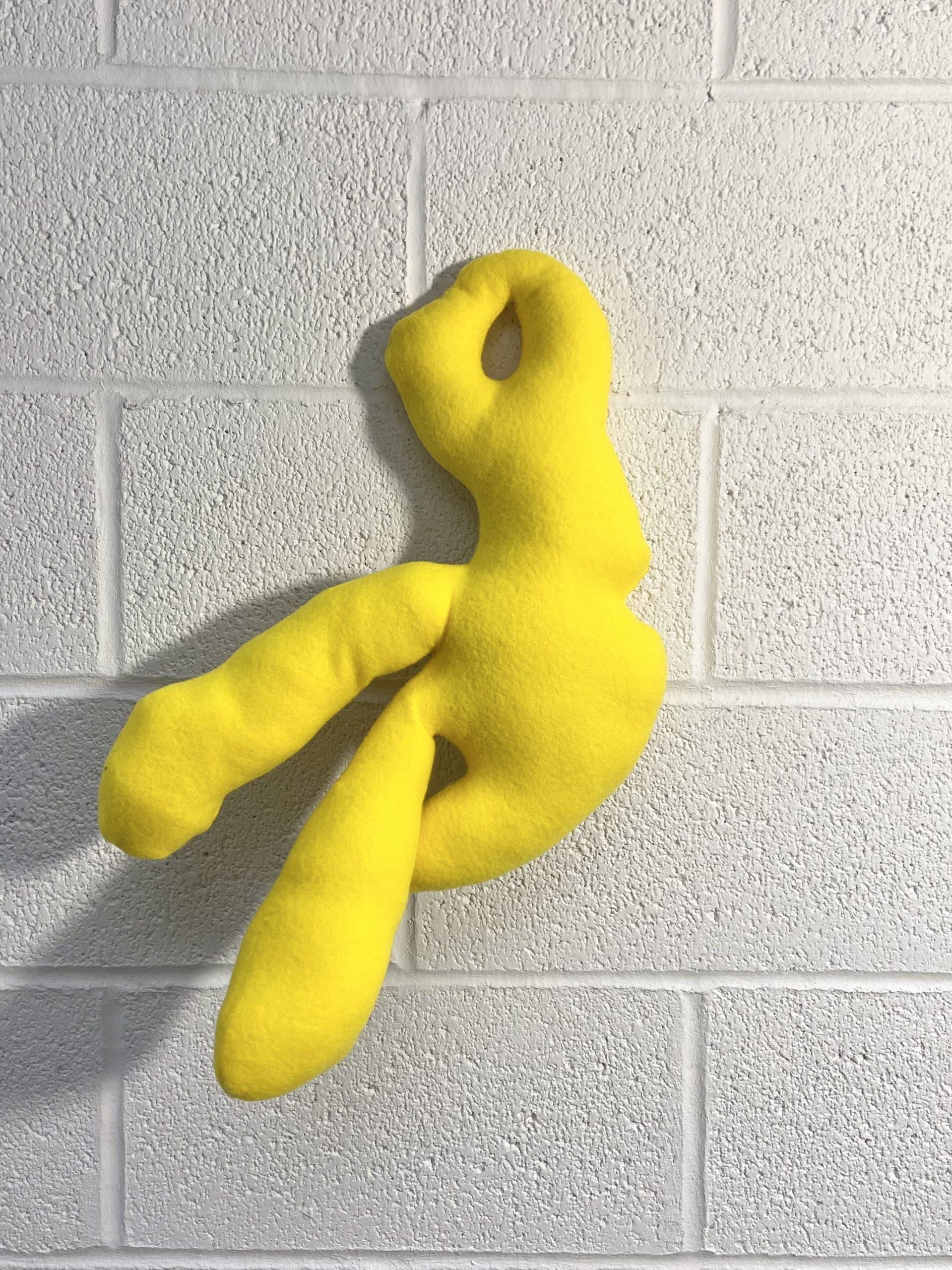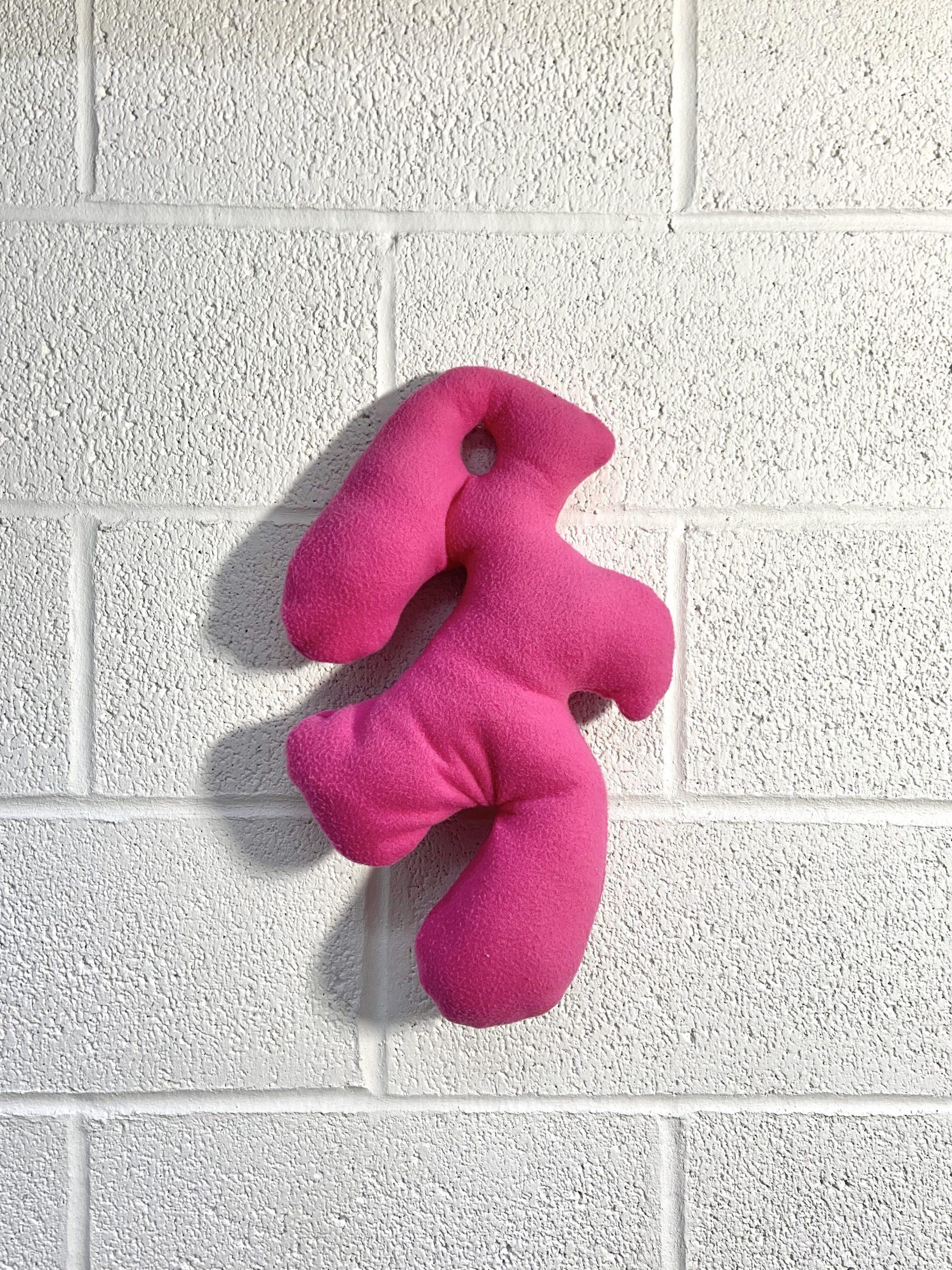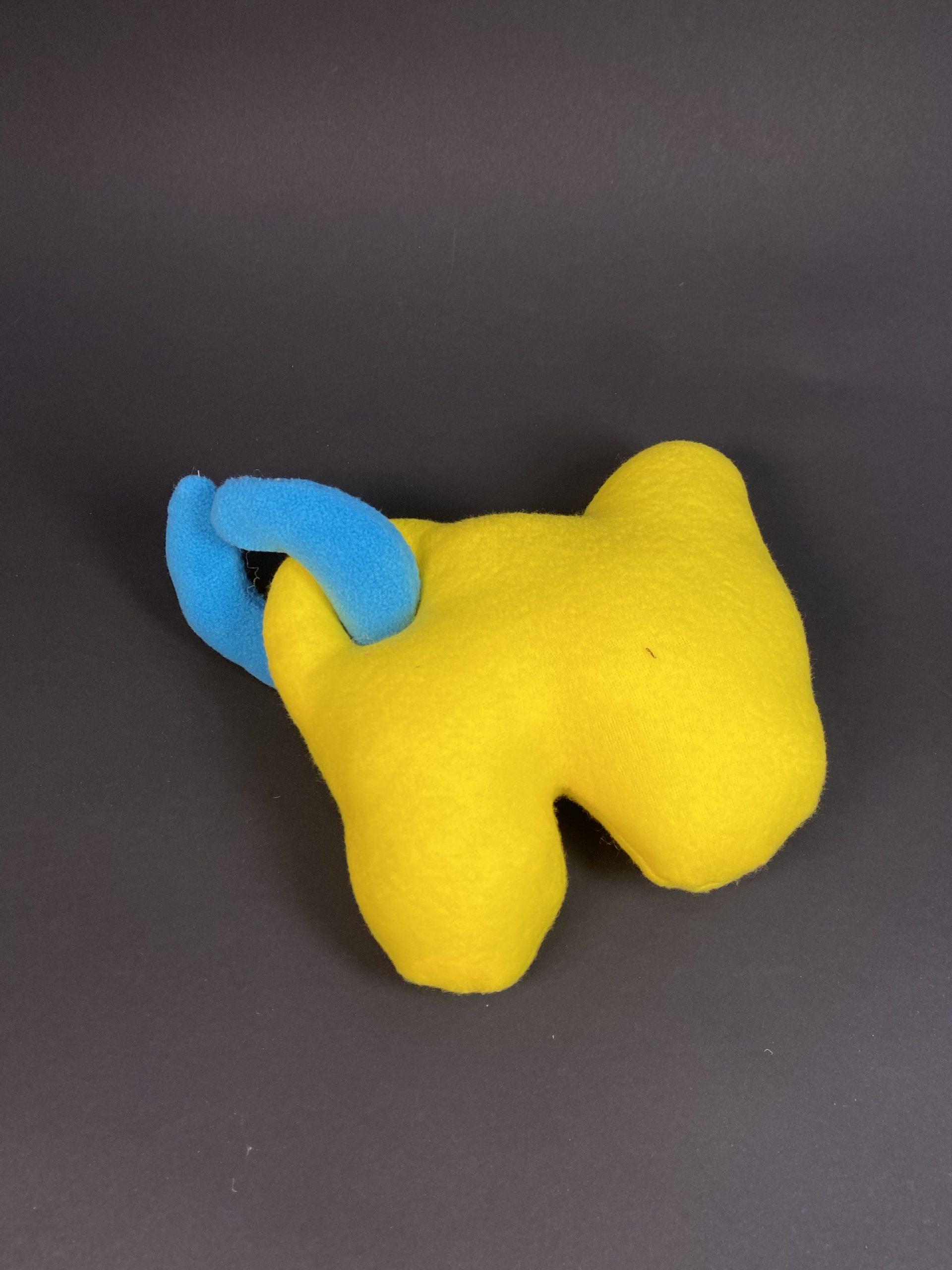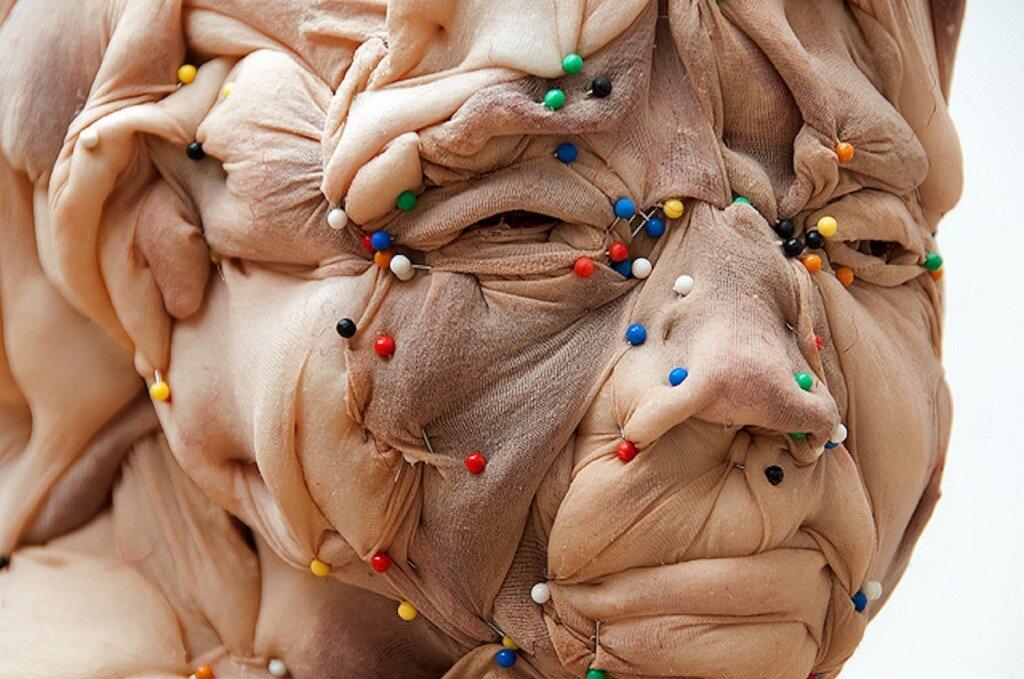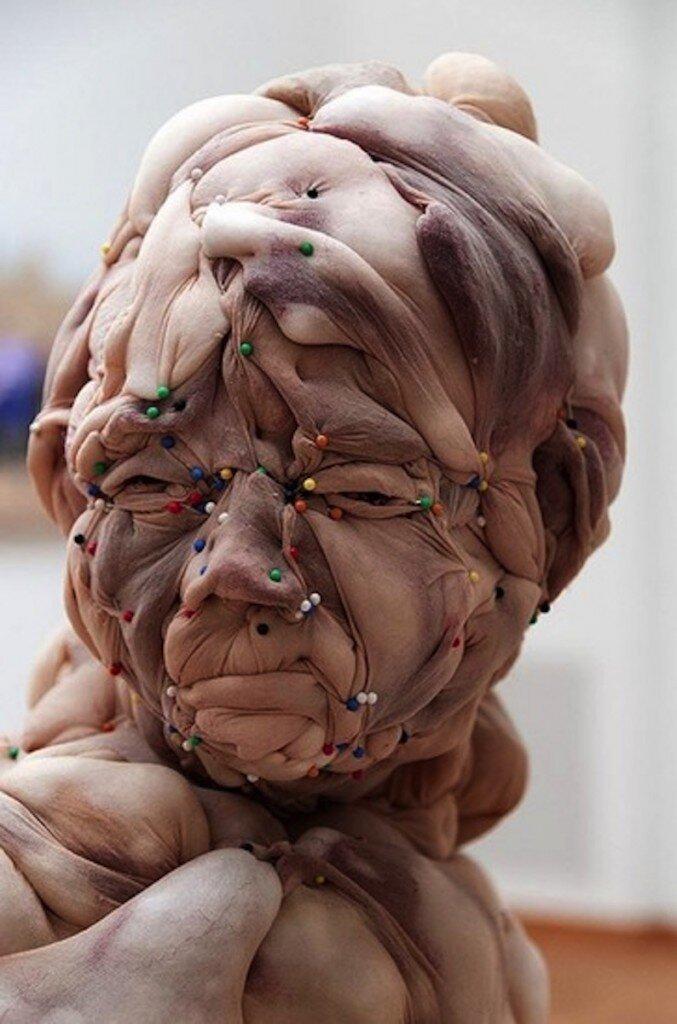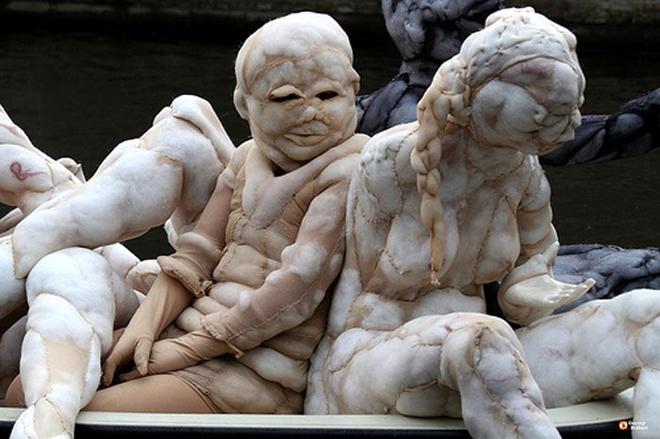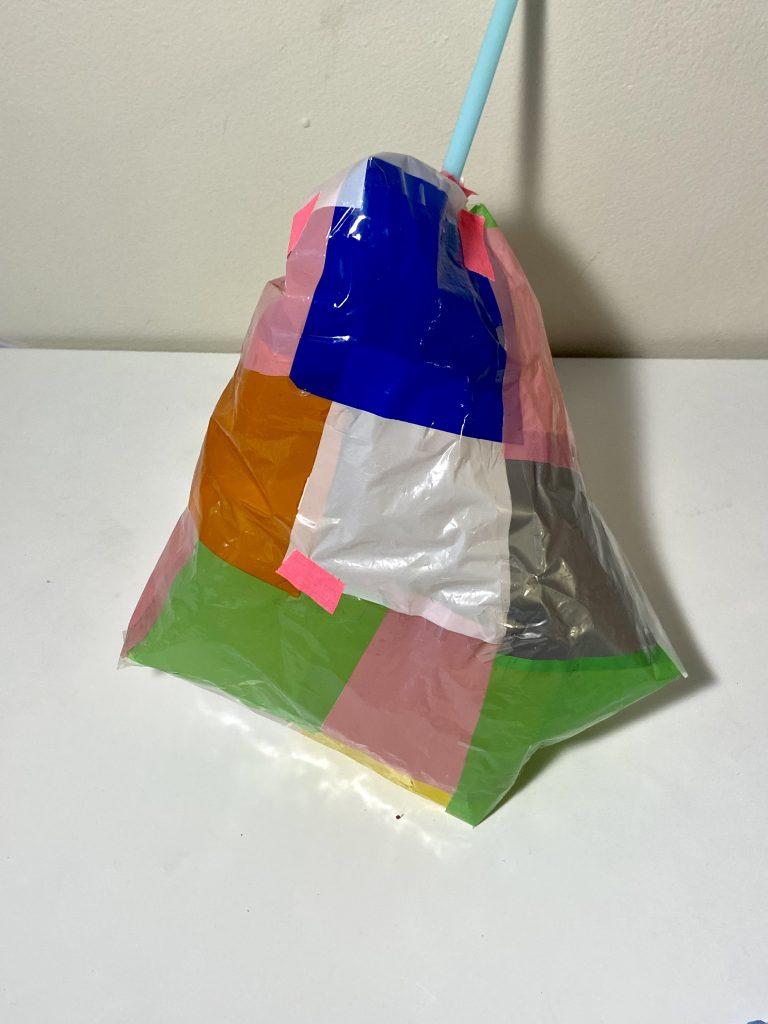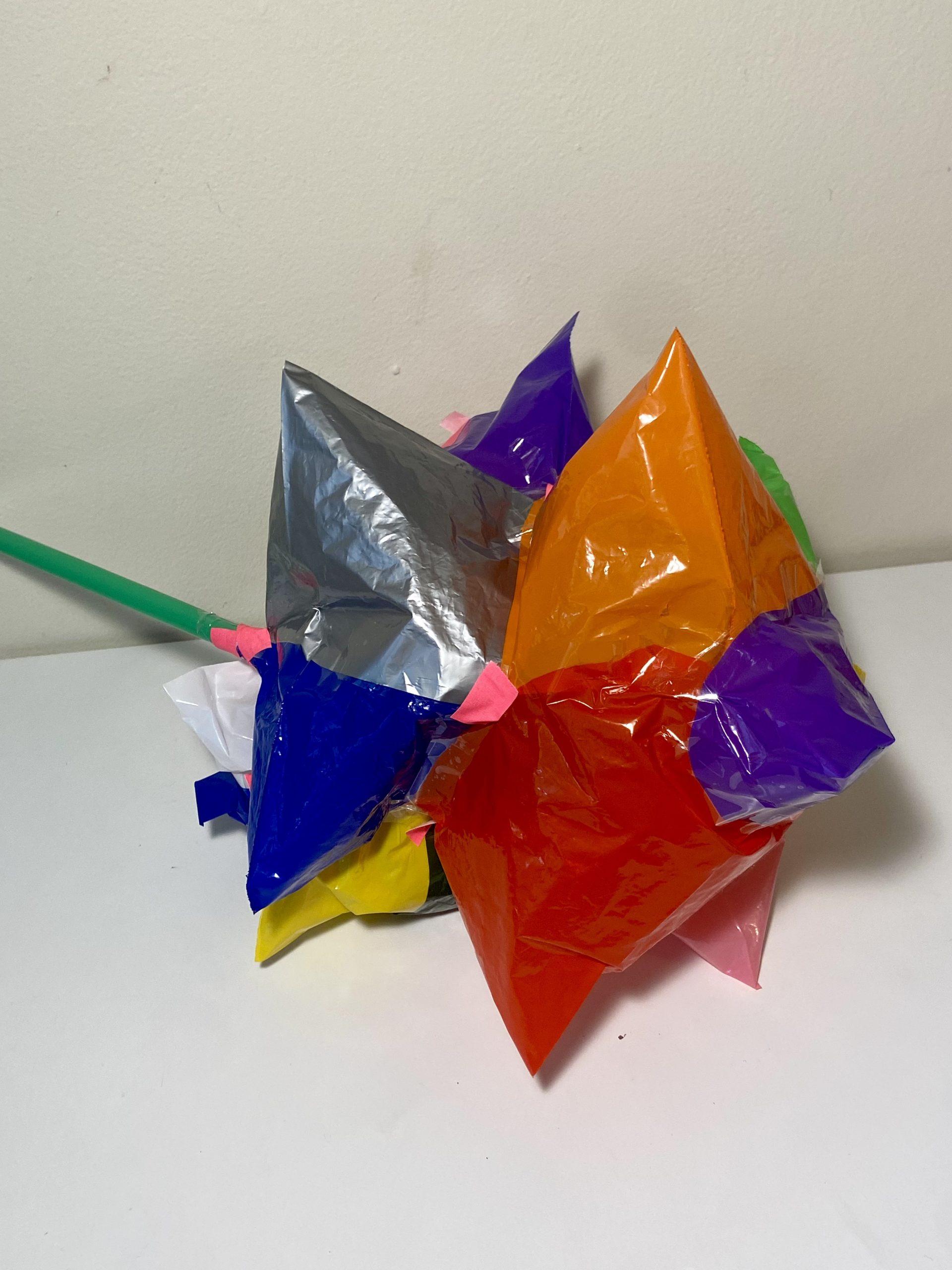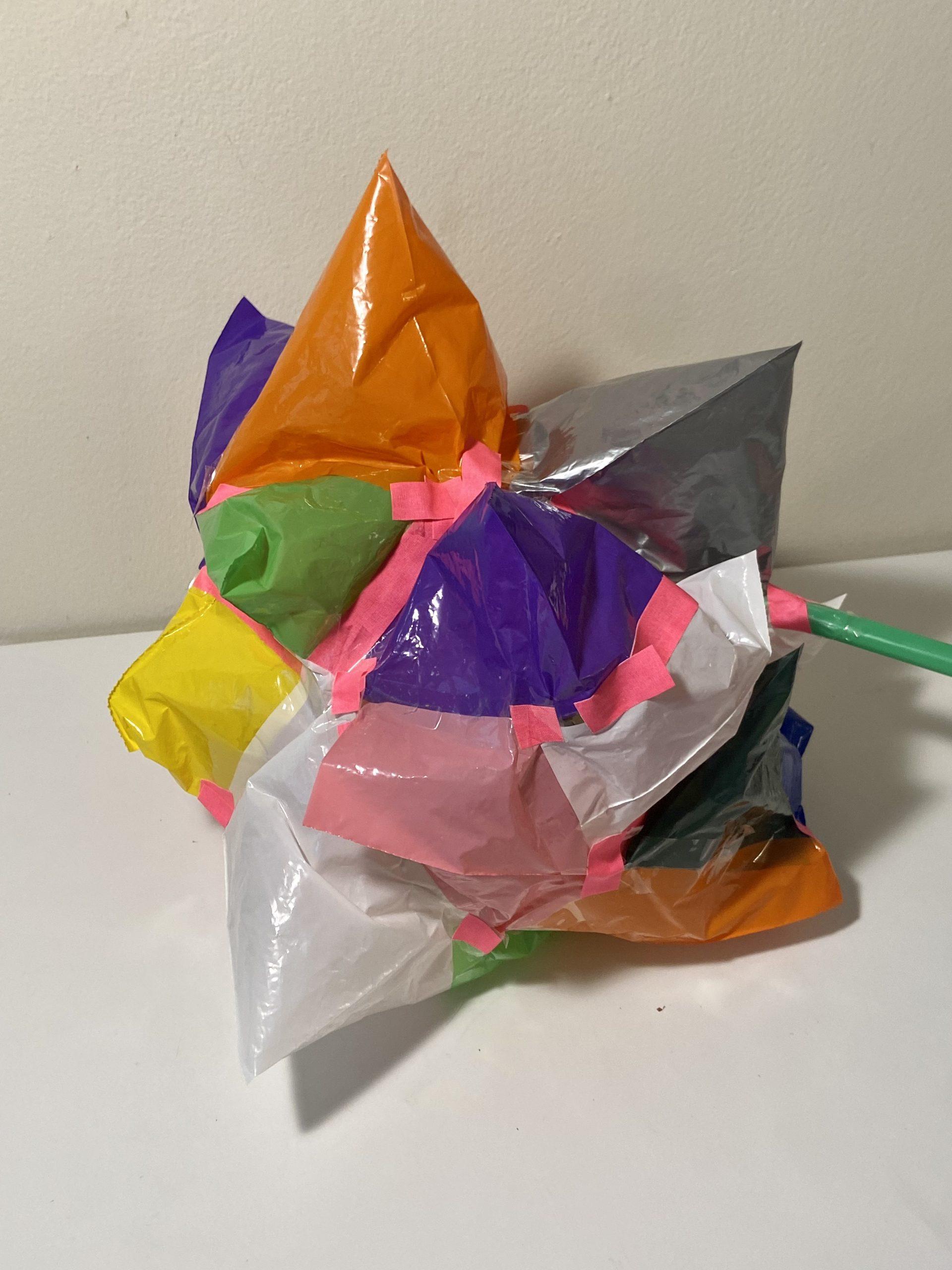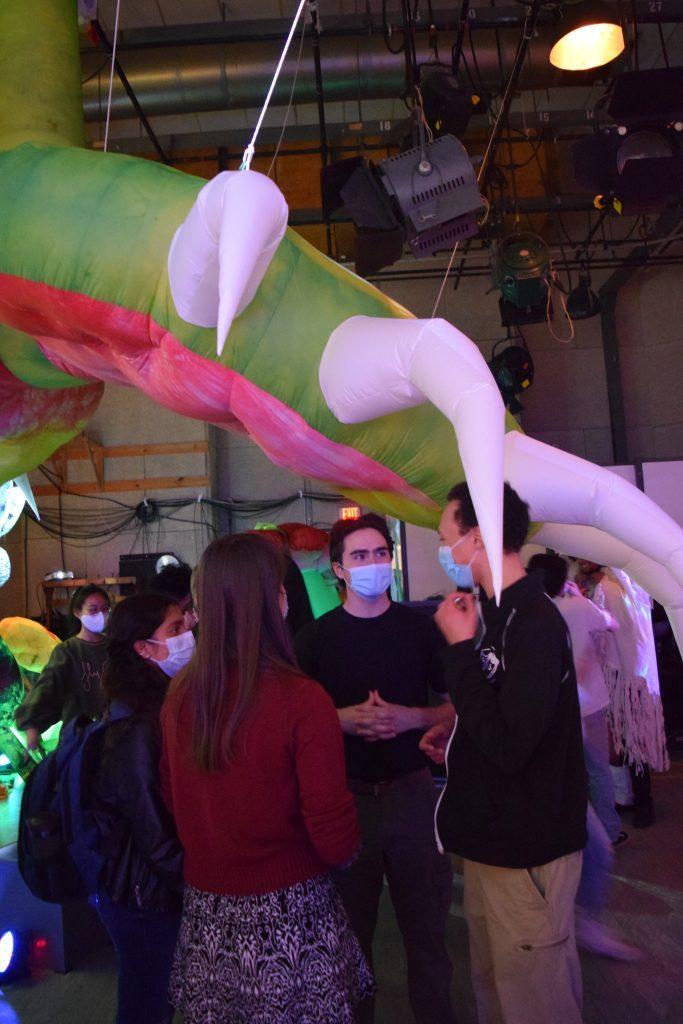
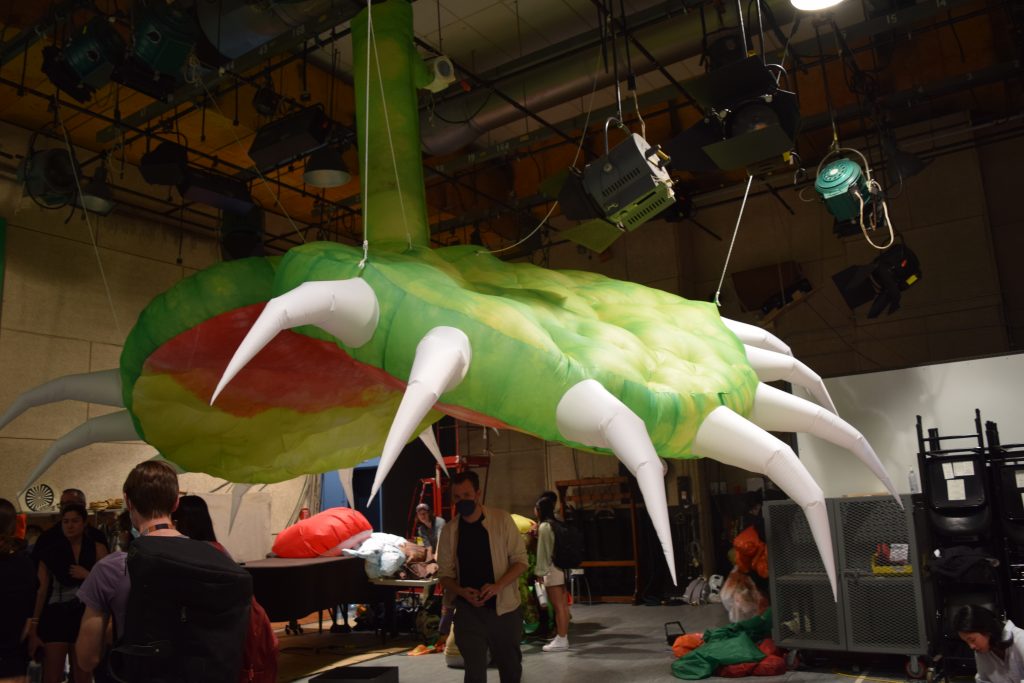

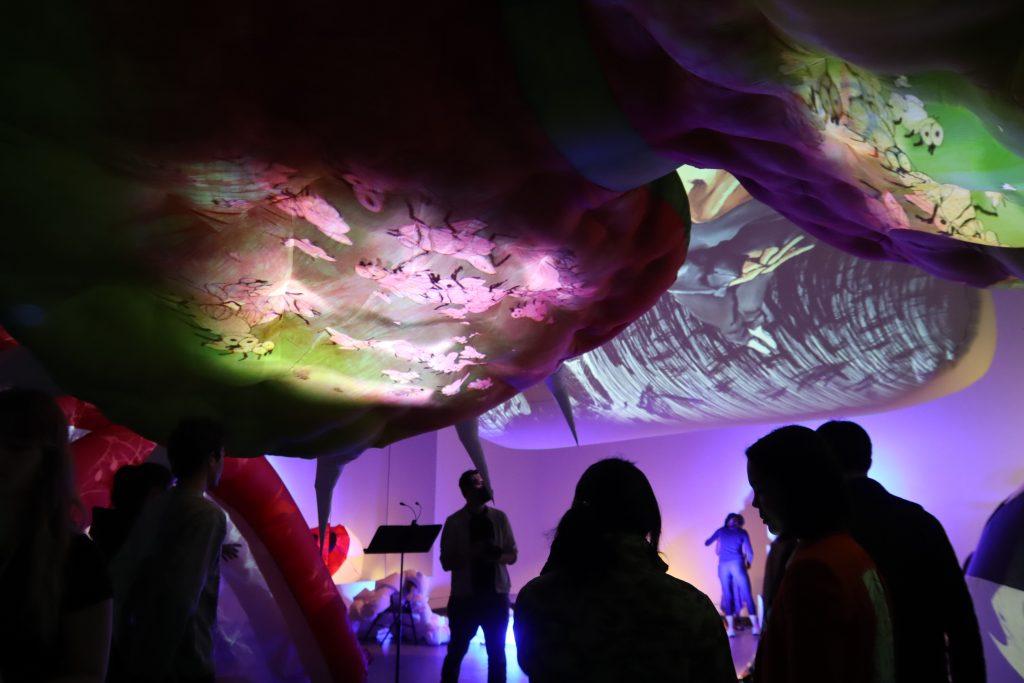
The project
The Venus Fly Trap is a giant inflatable installation including projected animations of flies on the inside walls. It hangs from the ceiling, opening over the audience as if it were about to capture the people underneath. The Fly Trap is interactive, offering a space for communication, storytelling, and wonder.
Ideation
We all wanted to make a project that was interactive and hanging from the ceiling and came up with a lot of different ideas. Jennifer suggested we make a fly trap, and we went with it because it felt like the most tangible project.
Process
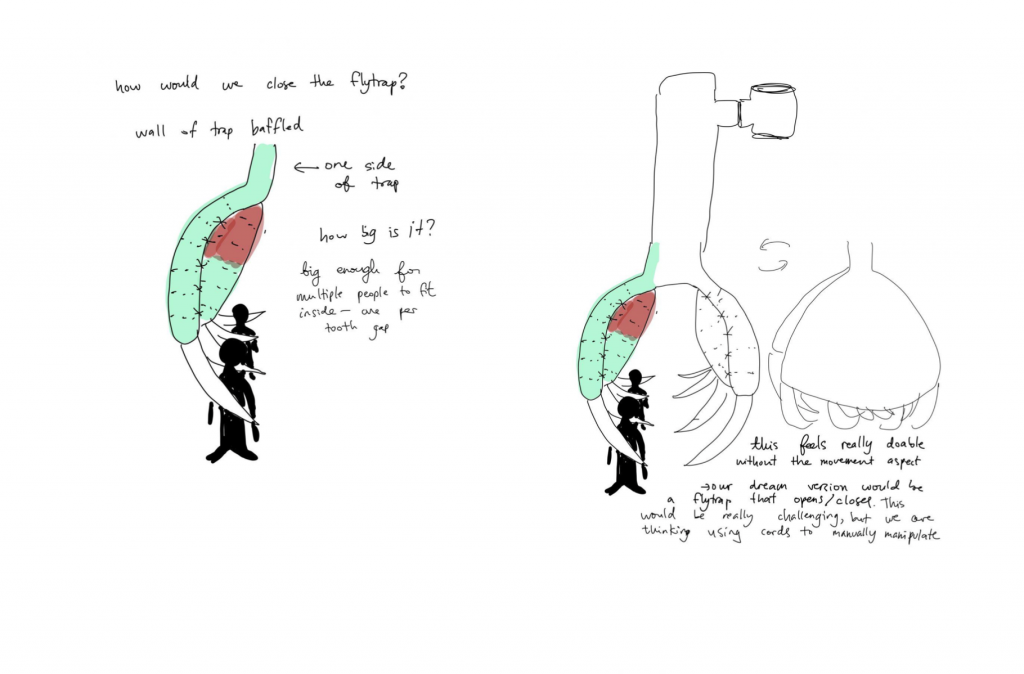
First, we made sketches of what we imagined it would look like. We imagined a fly trap that could open and close, that would hang over people and consume them as the teeth closed around their bodies.
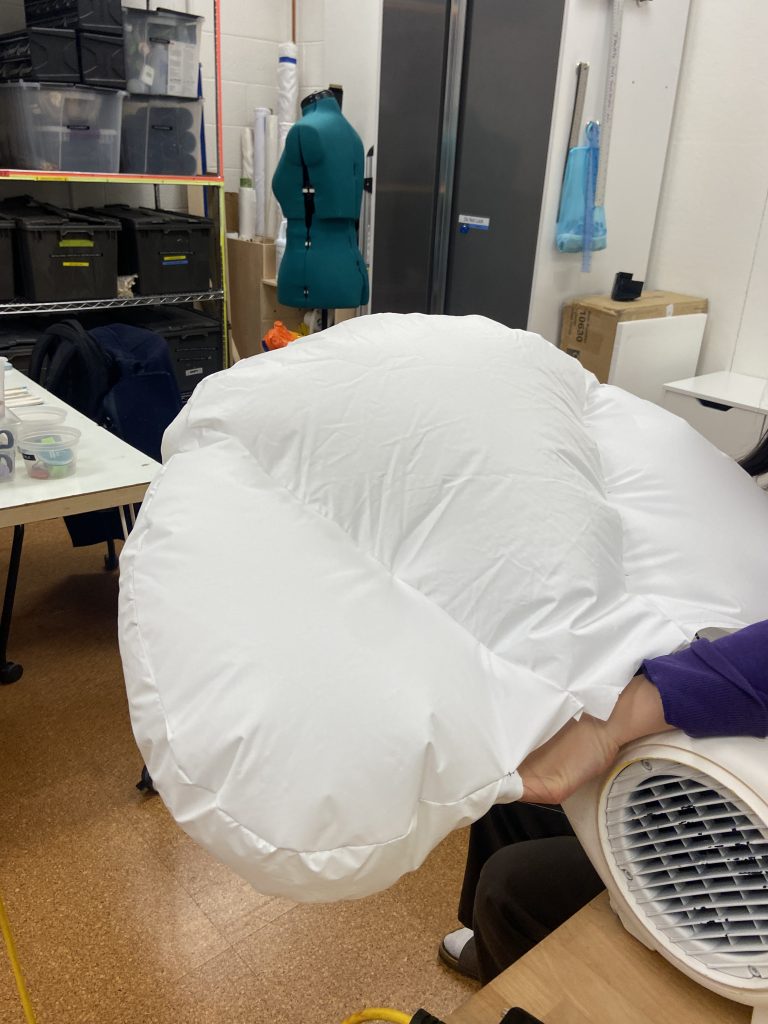
Then, we made a couple of mockups of the sides to test baffling, angle of connection, and teeth construction. None were really that successful, but we realized it was likely an issue with scale and took construction ideas from the mockup into account when designing the full piece. One aspect of the mockup that was particularly successful was baffling. We cut the leaf into pieces along lines that made it look like the leaf’s veins, sewed strips of fabric into those seams, then tied them together once both the inside and outside walls were connected. We expanded on this idea when making the pattern for the walls of the flytrap, making sure to consider symmetry for ease of construction.

We made 12 paper pattern pieces to make 96 total pieces for the four walls of the flytrap.
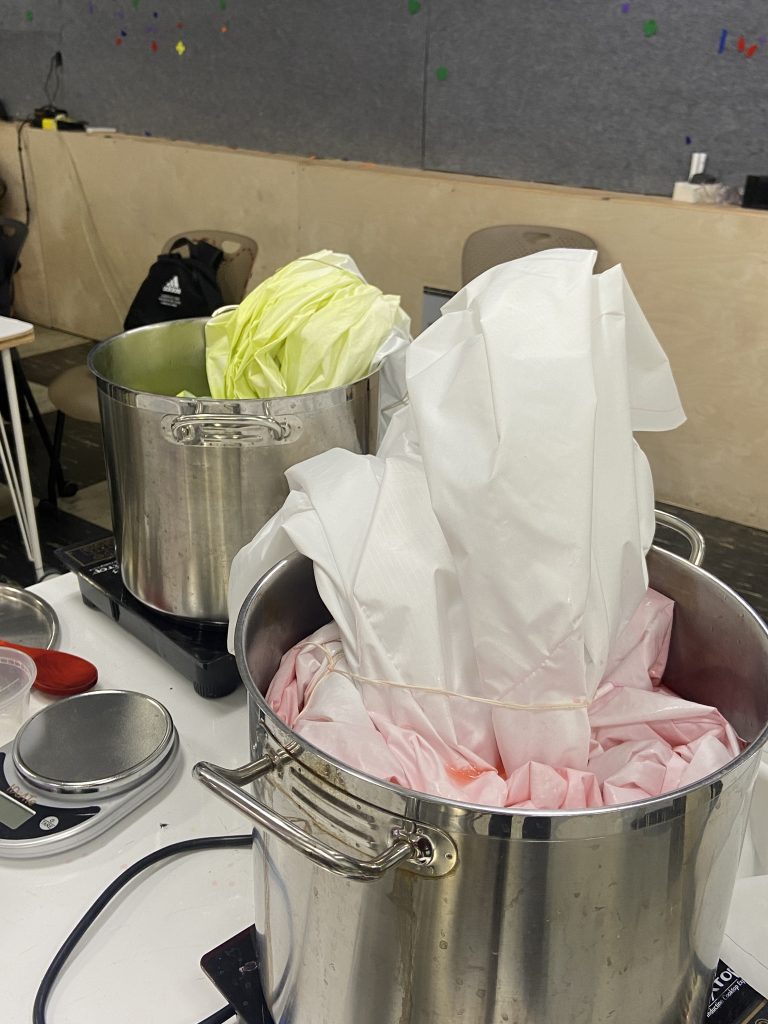
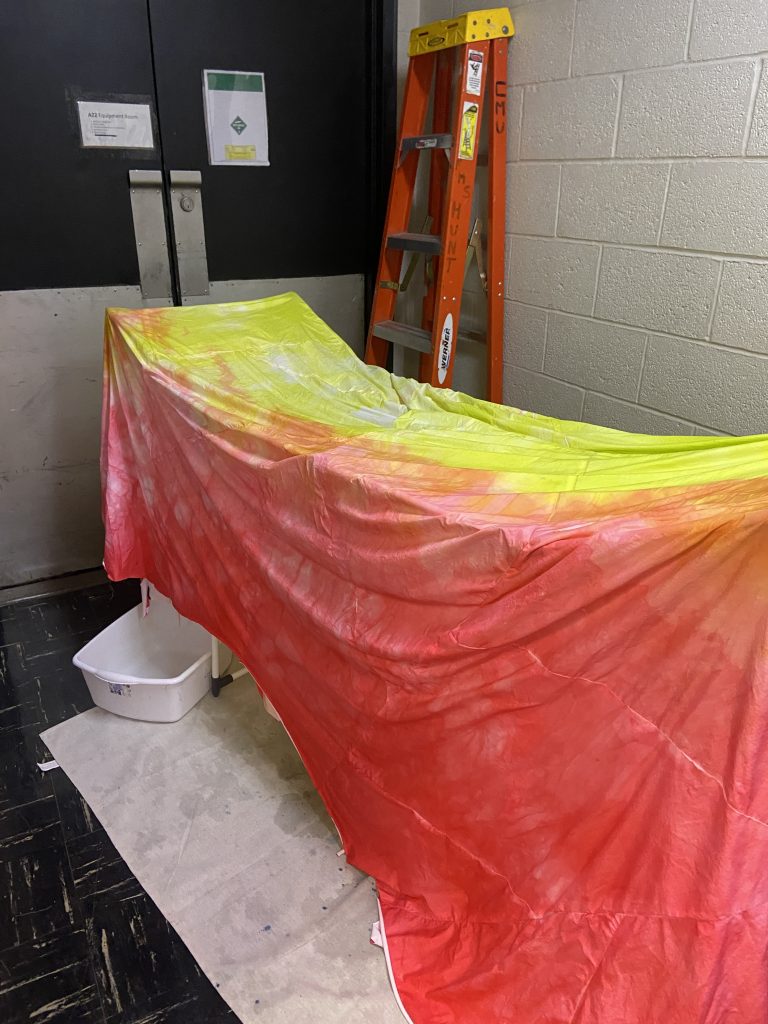
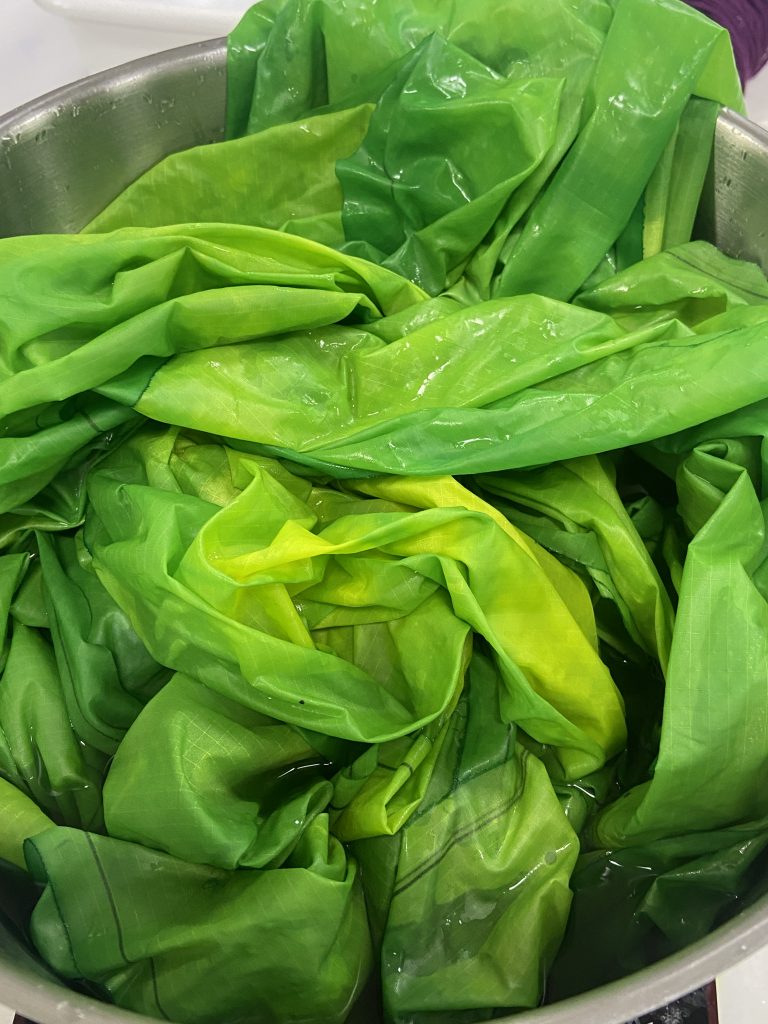

We sewed them together with the ties and dyed the inside walls with a gradient and the outside walls green.
When we dyed the outside walls, the dye bath got a little too hot and melted the protective coating on the fabric. It was all gloopy, but it actually looked pretty cool.
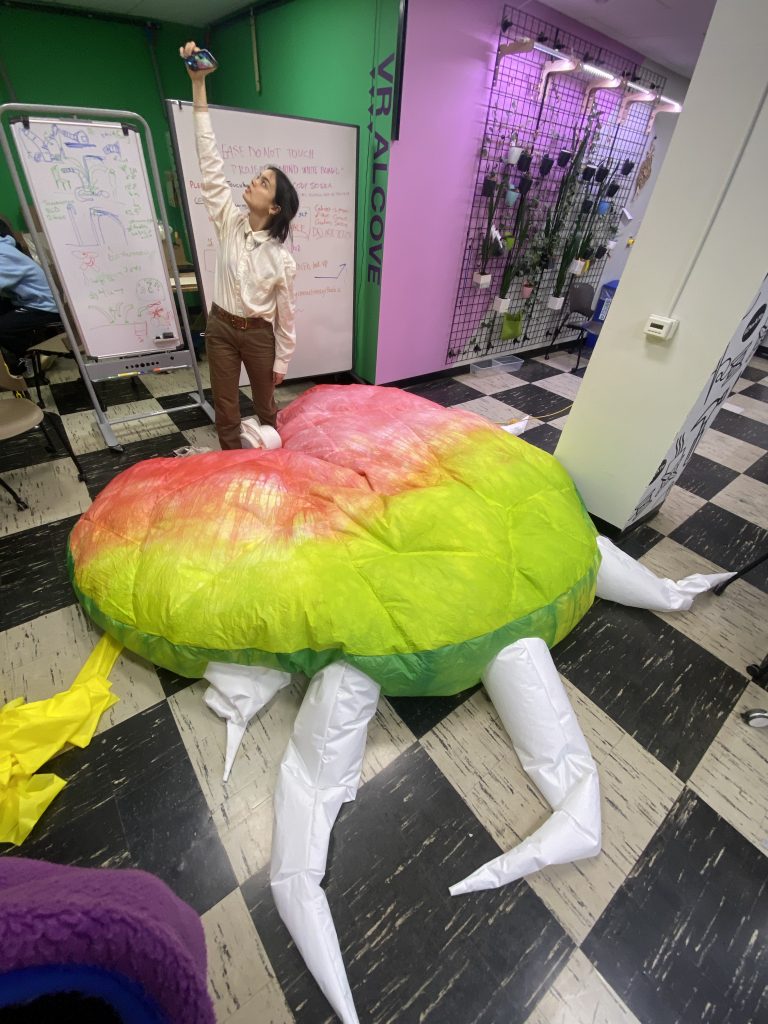
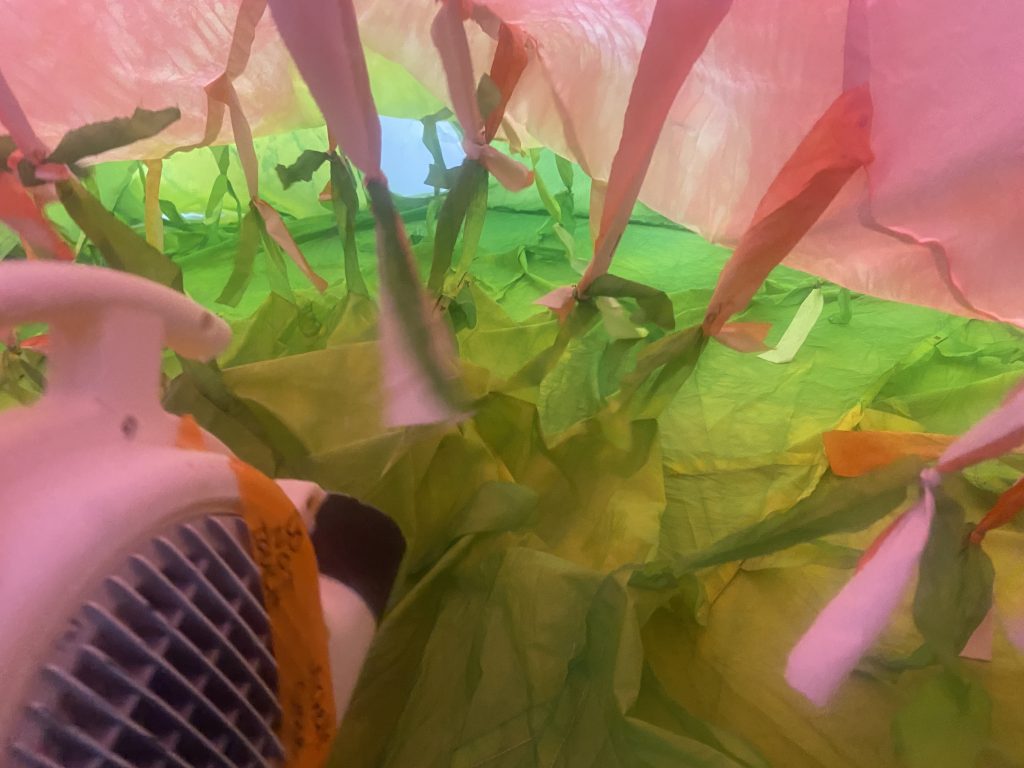
Next, we made the connecting walls with the teeth and attached them to the inside and outside walls we previously made. We tied all the ties together inside each wall, then connected the two walls with a central piece. Understanding how we would connect the two walls was very challenging.
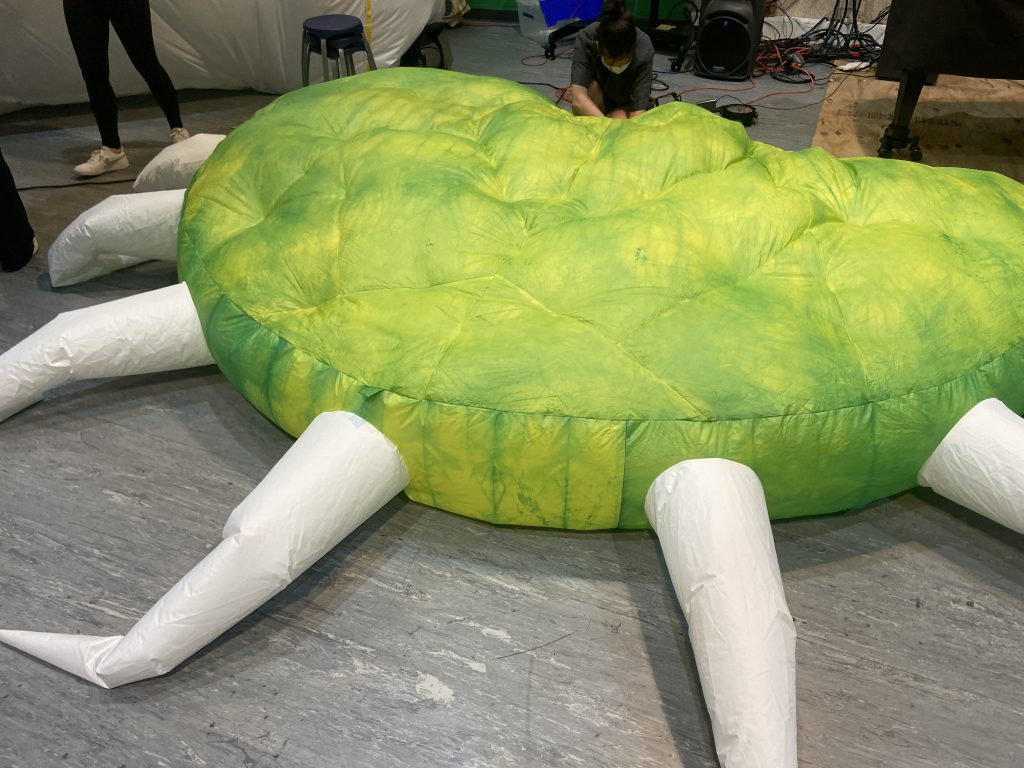
We tried to plan for it but kept getting confused, and eventually just decided to improvise it. We were trying to make a complex connection between the walls of the flytrap and the stem but ended up going with the simplest solution possible and it ended up working. Finally, we made the stem and the tabs that the flytrap would hang from.
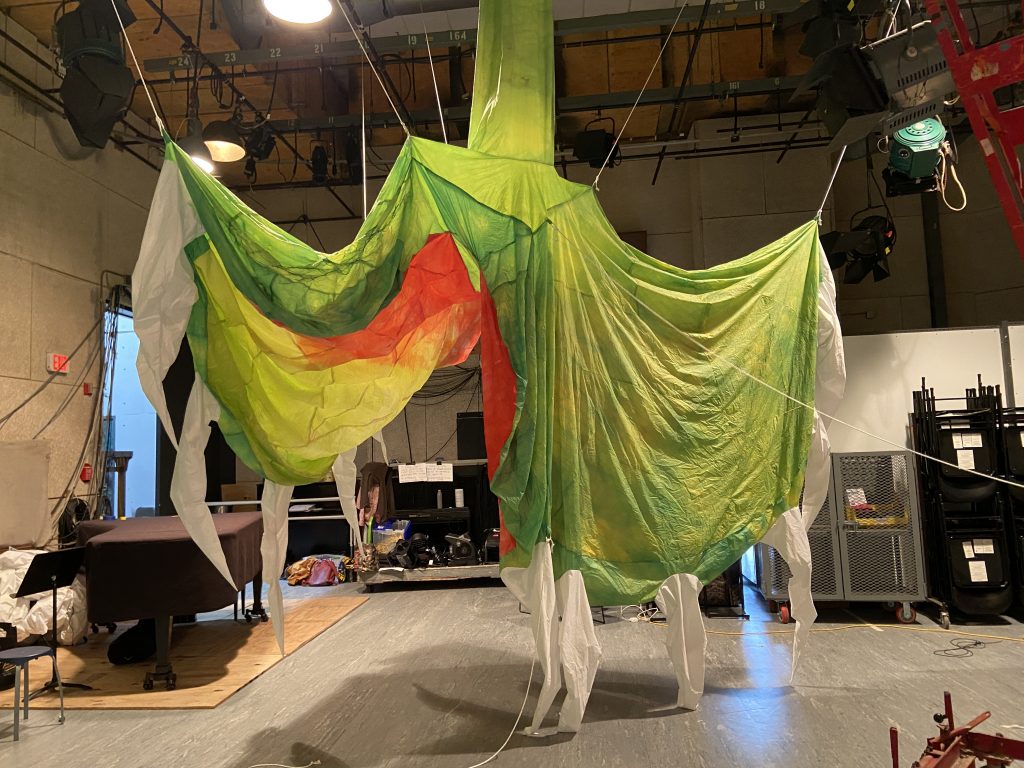
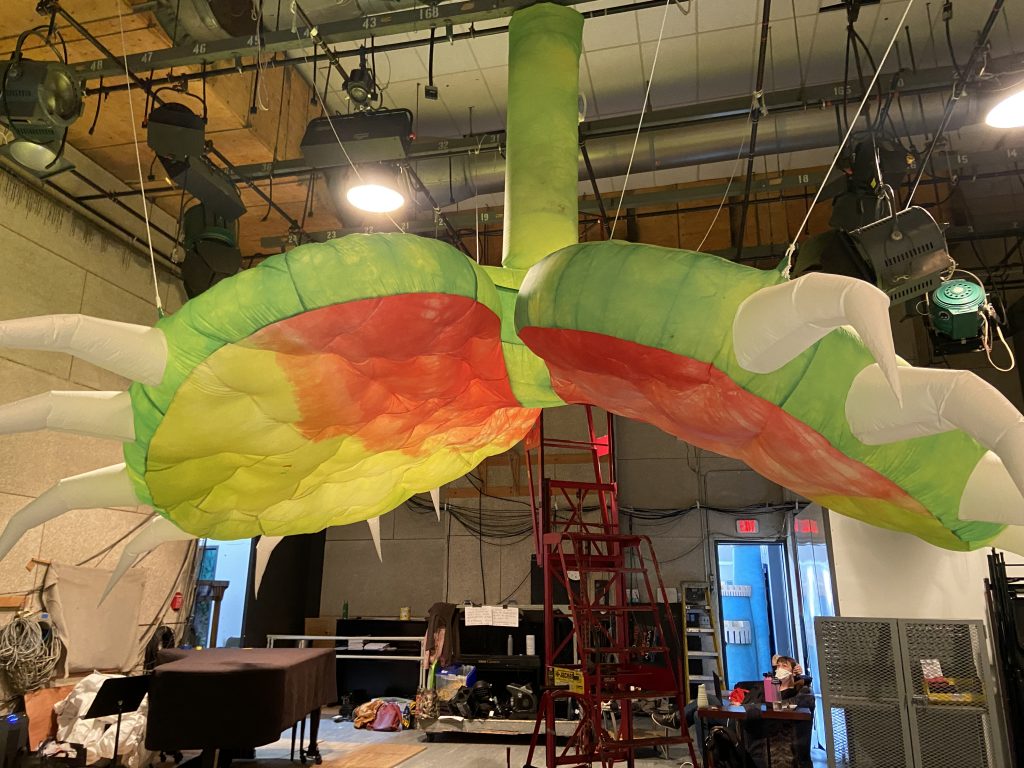
Once the fly trap was fully constructed, we did a test inflation at WQED.
Jennifer
I am really proud of the dye of the fabric. We tried several techniques and had fun, and the final result was true to the original plant. Also, I am happy with the shape and overall scale of the project. It was something that we did not know how it would turn out, so seeing it being so grand in the space was amazing.
At one point, I was extremely stressed out about the amount of work that I had to put in and worried about not finishing everything on time. Communicating with the team and sharing the frustrations to work together really helped. Figuring out how to create the overall shape was something I was worried about for the longest time. With our several initial mock-ups and creative improvisations with the team, we were able to successfully create the overall shape, slightly slanted leaves coming from the ceiling.
I learned how to collaborate creatively with others, especially those not coming from the same background. I am so used to working with other artists and being able to work together was such a valuable experience. I want to continue creating works on this giant scale. Finally, I learned so much about time management.
I learned how to listen and follow other people’s directions. I am used to being in control, especially since I do it alone when I am making my own artwork. So having other people, who have skills that I don’t have, and working together to come up with solutions was new to me but also so reassuring and comforting.
Everything you make will look so impressive and amazing, so don’t stress out.
Kavya
I think we were successful with our planning process starting with a small mockup, planning out our expanded design, and then cutting and sewing our final piece. This helped us create a shape that we were confident about looking good, and then scale it up instead of our initial thoughts of using rhino where we wouldn’t have known how the shape and baffles would hold. I also thought our dyeing was really successful as we were first unsure about how the green to red gradient would look and how the white teeth might look off, but the teeth actually really stood out with the white ripstop which I really liked.
A personal challenge I encountered was getting covid and not being able to be at hunt for over a week to help, but we did our best to work around that with me renting out a sewing machine and working on some of the sewing at home in quarantine to help out my group the best I can. We also had some problems with attaching the stem to the already sewed venus flytrap which required cutting and dyeing extra pieces and planning ahead on sewing better the second time.
The top three things I learned from this experience that I will take ahead into the future are patience when something isn’t working out or taking longer than expected, collaborating with teammates from different backgrounds with completely different skills, and how to work individually on a group project when we are not all working synchronously.
What I observed in myself regarding my collaboration with teammates is that we all had amazing but completely different ideas and with making a group project that was actually tangible versus coding/technical projects, we had to communicate a lot and make decisions before trying things out because we couldn’t just try all our ideas and see what works better as that would waste lots of time and material. It helped me learn to not always rely on trial and error and to discuss the pros and cons of all ideas beforehand.
The number one piece of advice I would give to future students in this course is not to be a perfectionist. Yes, planning ahead and being neat are two important skills to finishing an inflatable, but I struggled many times with stitching not being exactly on the line like I wanted or two pieces not being exactly the length we wanted to fit them together. Though it would be great if this always worked, I had to learn that at such a large scale, if I wanted everything to be perfect we would be working on one inflatable for months or years and we had to prioritize completion over perfection. In the end, with the giant inflatable you can’t even notice these tiny mishaps!
Charlotte
In making the flytrap, a crucial part of understanding how we would take on the project was making sketches and mockups. We had never made anything of that scale before, so making mockups was an approachable way to understand construction. I personally really appreciated our hands-on analog approach to project design; I’ve always had a tough time with CAD. I thought that our design approach allowed the form to be intuitively constructed without the distracting complications of CAD. Having to think that way also improved my own skills with imagining 3-D objects in space and the primary forms that they comprise of. Dyeing was also a crucial aspect of our project. I was afraid it would make our timeline for executing deliverables very challenging (it did), but it felt necessary for the kind of object we were creating. When I saw the final completed project, I felt like the dyed fabric was one of the most compelling elements that really brought the fly trap to life. Finally, I was very worried about our ambitions about having the fly trap hang at the beginning of the process, but being able to execute it was very satisfying. Having the fly trap hanging created a space underneath that seemed like an important aspect of our final project that I couldn’t imagine any other way. We would not have been able to hang the fly trap without the help of the team at WQED.
The biggest challenge in making the fly trap was having to dye every part of the inflatable. Due to poor planning and expectation of material needs, we ended up having to dye fabric a total of four times. We overcame this challenge mostly just by working a lot, but a better way to prevent such a problem would be to plan better, take more careful measurements, and handle construction more meticulously. Another challenge we faced was the presence and availability of all our group members. Sometimes, unexpected things come up and not all members of a group can be there even though we had expected to be all available. In one particular situation, the members that were able to be in person prepared materials for another person who had to be remote, and they worked on the project asynchronously. While it was challenging, it ended up all working out and showed us that working together on a project can take on many forms. In general, when we weren’t able to work on things together, we communicated as clearly as possible in order to make sure we were all on the same page.
The three top things I learned from this experience that I will take into future project experiences are trust, vision, and excitement. The most important of the three is trust. I had a lot of misgivings about the ambition of our project, the steps we would take to make it, details of construction, and more. I was really nervous about the project and I think feeling that way made the project challenging for me and my group members. Being anxious about the project did not serve anyone or even the project itself, and when I could trust that everything would be okay, work went the smoothest. Another thing I learned from this project is the importance of having a vision for what we want to create at the beginning of the project. Even if you don’t have all the details down in the beginning, it’s important to think about what kind of experience you want to create, what features you want to focus on, what it is you want to make, and so forth. Having such a clear vision at the beginning of the project is what helped us make concrete goals at the beginning and throughout the project. Finally, I learned during this project that excitement about what you are creating is an important feeling to have if you are going to work very hard and if you want to make something good. The more excited you are about a project, the more you want to feel responsible for it, and then the more you want to work on it a lot. This project had a lot of flexibility and creative control, but I hope in future projects where I may have less of that I can find little things I am excited to feel responsible for.
In terms of collaboration when different members have different skills, I’ve found that if there’s not enough time to share skills, it is actually most effective to divide work according to skillset. For example, it would be terrible if I was tasked with making CAD mockups not only because I would hate it but also because it would take forever and not be high quality etc. I got to learn a lot from my teammates especially because we all come from different academic backgrounds.
This is so cheesy but my number one piece of advice to future students is to have fun. I had so much fun in this class and it made all the work worth it. I loved being silly in group warm ups and exploring new ideas even if they didn’t turn out so awesome. It was great to meet all these insanely talented people in my class all from different backgrounds. Having fun and being excited will result in your best work and the best experience you could have in the class.


